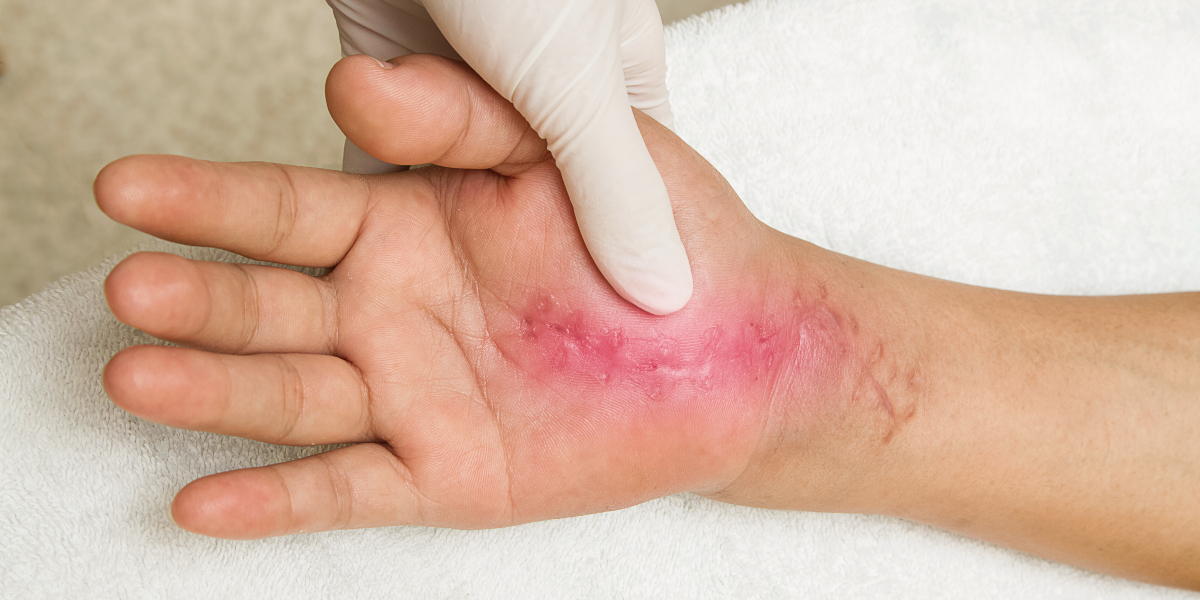
Laser Therapy for the Repair of Scar Tissue & Heal Wounds
Wounds and scars are a part of life. However, wounds that are difficult to heal or scars that are large or carry emotional weight can impact our lives in a big way. There are a variety of topical treatments and in-office procedures to help with the wound healing and scar repair processes, including laser therapy. Laser therapy is a safe, painless treatment for wound healing and scar repair that improves the collagen production and alignment in the skin to resolve even slow-healing wounds.
Keep reading to see how laser therapy helps repair our skin.
How Laser Therapy Helps Heal Wounds
There are both internal and external wounds, and for the purpose of this blog we’ll focus on how laser therapy helps heal external, or cutaneous wounds, like cuts, scrapes, incisions, or any break in the skin. Sometimes wounds are accidents, like scraping your knee when you fall off your bike, and others are intentional, like a surgical incision, but both take time to heal. While most minor wounds resolve quickly on their own, larger ones can require intense care for weeks to properly heal. Additionally, some chronic conditions, like diabetes, can impact that wound healing process and make it hard to fully heal wounds.
Laser therapy uses red and near infrared light in a safe concentration to boost cellular energy and increase cell proliferation, which contributes to wound healing. Laser therapy has been shown to stimulate cellular metabolic processes as well as adjust signaling pathways responsible for wound repair, like cell migration, DNA synthesis, cell mitosis (replication), and protein secretion. In addition to assisting the wound healing process, laser therapy can reduce pain and inflammation from an open and healing wound.
How Laser Therapy Repairs Scar Tissue
While ideally proper wound care prevents or minimizes the formation of scar tissue, scars may still form or we may have existing scars from previous injuries or surgeries. Scars form when the dermis of the skin is damaged, and the body forms new collagen fibers to repair it. The dermis is the deep layer of the skin that contains blood capillaries, nerve endings, hair follicles, and other structures.
Scars can happen as a result of trauma like a cut or scrape as well as a result of certain diseases. Cystic acne may also leave scars, and stretch marks, such as from pregnancy or a growth spurt, are also a form of scar. Some smaller scars may heal overtime on their own, but others are with us forever. In addition to potentially impacting our confidence, scars are also delicate patches of skin. They can burn more easily in sunlight, which can cause discoloration as well as pain, and scars can react differently to topical products than regular skin.
Scarred skin has collagen fibers that are misaligned. Normally, collagen proteins arrange nicely in a matrix, but in scarred skin—collagen isn’t aligned in a nice matrix. Treatments to reduce the appearance of scars often go about re-injuring the skin in a way so the collagen can realign properly. Procedures like injections and microneedling as well as dermabrasion treatments do this. However, laser therapy has been shown to promote reorganization of tissues and affect cell interactions to increase collagen bundle density and size—sans needles—which reduces the appearance of the scar by repairing the collagen matrix.
Benefits of Laser Therapy for Wound Healing & Scar Repair
Wound care and scar repair are intensive processes that can require multiple clinic visits. Laser therapy is no exception to this rule—to achieve the best outcomes, multiple visits (generally between 6 and 12) are necessary.
However, laser therapy is a painless treatment. You and your laser technician will both need to wear safety glasses, but the procedure is safe and relatively short, between 3 and 20 minutes. Laser therapy is a great option for scar repair if you’re not fond of needles or are concerned about infection. Laser therapy is also a good option for healing wounds and scars if you have sensitivities or allergies to ingredients in topical solutions.
If you’re interested in getting started with laser therapy, click the link below to find an Aspen Laser provider near you. With over 200 locations worldwide, you can find a laser therapy provider in your neighborhood.





No comment yet, add your voice below!